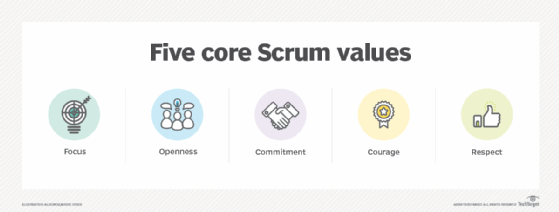
filo/DigitalVision Vectors via G
What are the 5 Scrum values?
Scrum defines five key values: openness, courage, respect, focus and commitment. Here's why they are important.
Scrum is an Agile software development framework. It provides a set of iterative steps and processes that teams should follow to build products in a manner that do the following:
- Minimize risk.
- Maximize predictability.
- Prioritize transparency.
- Encourage creativity.
Scrum also comes with a set of five core values.
The 5 Scrum values
The foundation document that describes what Scrum is and how Scrum should be implemented is the Scrum Guide, written by Jeff Sutherland and Ken Schwaber. According to the guide, practitioners must be proficient in and embrace the following five Scrum values to be successful. The five Scrum values are as follows:
- Openness.
- Courage.
- Respect.
- Focus.
- Commitment.
These values do not exist independently from one another, but instead work together. Here's how:

Openness
Agile software development teams are made up of highly motivated individuals, who are all depended on for the development effort.
To be open means a Scrum team creates a psychologically safe environment where everyone on the team is free to speak their mind without fear of reprisal.
Members of a Scrum team must always be open to feedback, suggestions and even criticism. Meetings should be open to all, everyone should be transparent about the work being done and anyone on the team should be able to add items to the project's product backlog.
Courage
Don't rock the boat. Toe the line. Let sleeping dogs lie.
The English language is full of idioms that praise inaction. However, small problems can become systemic if nobody has the courage to speak up, propose a new direction for the team, point out shortcomings or speak the truth.
Scrum masters work hard to create a psychologically safe environment where developers can speak openly and freely. But Scrum still requires individuals to demonstrate courage when it comes to speaking honestly and truthfully about the product development process.
Respect
For individuals to show courage, members of a team must respect each other and their insights.
When team members are needlessly critical, dismissive and disparaging, they discourage others, diminishing the desire others have to demonstrate courage.
Furthermore, individuals must respect the decisions of a self-organized and self-managed Scrum team.
The desires of a director or project manager can run counter at times to the advice of the Scrum team. However, you don't hire skilled, competent and highly motivated developers so you can tell them what to do. You hire them so they can tell you what needs to be done.
Individual Scrum team members must respect one another, and stakeholders who exist outside of the Scrum team must respect the collective decisions the team provides.
Focus
When individuals on a team are open with each other, have the courage to speak honestly about obstacles and the opinions of others are respected, the team can build a consensus about how to act and focus on a common goal.
Every product development effort in Scrum starts with a product goal that provides focus.
Every sprint -- a set period of time in which work must be completed -- has a goal that team members focus on.
Every product backlog item has a clear definition of done that developers must focus on achieving.
Furthermore, development efforts are to never last more than 31 days, as Scrum sets the maximum timespan of a sprint to a month.
With the ability to focus on tasks that span a short time, well-aligned teams are more likely to come to an agreement about what needs to be done and how to accomplish their objectives. This leads to more productive product development efforts.
Commitment
Finally, when a courageous team of developers who respect each other can communicate openly and agree on a common focus, they can commit to a plan of action.
When individuals commit to achieving a common goal, hesitancy goes away, impediments are quickly identified and work to remove roadblocks is prioritized.
Darcy DeClute is a technical trainer and Agile coach who helps organizations apply Scrum-based principles to adopt a modern DevOps stack. She is a certified Professional Scrum Master (PSM), Professional Scrum Developer (PSD) and Professional Scrum Product Owner (PSPO), and author of the Scrum Master Certification Guide.




